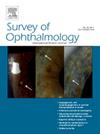Pediatric blepharokeratoconjunctivitis: A challenging ocular surface disease
IF 5.1
2区 医学
Q1 OPHTHALMOLOGY
引用次数: 0
Abstract
Pediatric blepharokeratoconjunctivitis (PBKC) is a chronic and recurrent ocular surface inflammatory disorder affecting children in early life. It is frequently under- or late- diagnosed, representing a potential cause of severe visual morbidity worldwide. An expert panel consensus recently agreed on its definition and proposed diagnostic criteria for suspected and definitive PBKC to reduce confusion and avoid varied terminology previously used in the literature, improving early and precise diagnosis. Previous evidence has pointed to the role of the adaptive immune system in recognizing and handling antigenic eyelid bacterial products, particularly from the cell wall, and the direct toxic and inflammatory effects of their cytolytic exotoxins on the ocular surface. PBKC is a frequent referral in pediatric and cornea clinics characterized by a history of recurrent chalazia, blepharitis, meibomian gland dysfunction, conjunctival hyperemia, phlyctenules formation, and corneal infiltrates with vascularization and scarring. The latter is a major cause of significant visual loss and amblyopia. Current treatment strategies aim to control inflammation on the ocular surface, halt disease progression, and avoid corneal involvement. Further research on pathogenic mechanisms will shed light on novel potential therapeutic strategies. Awareness of PBKC should enhance early diagnosis, prompt adequate treatment, and improve outcomes. We compile current evidence on epidemiology, pathophysiology, clinical spectrum of disease, diagnostic criteria, and management strategies for PBKC.
儿童眼睑角结膜炎:一种具有挑战性的眼表疾病。
儿童眼睑角化结膜炎(PBKC)是一种影响儿童早期生活的慢性和复发性眼表炎症性疾病。它经常被诊断不足或诊断晚,是世界范围内严重视力疾病的潜在原因。一个专家小组最近就其定义达成了共识,并提出了疑似和确诊PBKC的诊断标准,以减少混淆,避免文献中使用的各种术语,提高早期和精确诊断。先前的证据指出,适应性免疫系统在识别和处理眼睑抗原细菌产物,特别是来自细胞壁的细菌产物,以及它们的细胞溶解外毒素对眼表的直接毒性和炎症作用中的作用。PBKC是儿科和角膜诊所的常见转诊病例,其特征是复发性吸虫病、眼睑炎、睑板腺功能障碍、结膜充血、细泡形成、角膜浸润伴血管形成和瘢痕形成。后者是造成严重视力丧失和弱视的主要原因。目前的治疗策略旨在控制眼表炎症,阻止疾病进展,避免角膜受累。对致病机制的进一步研究将揭示新的潜在治疗策略。对PBKC的认识可以促进早期诊断,及时适当的治疗,并改善预后。我们收集了关于PBKC的流行病学、病理生理学、疾病临床谱、诊断标准和管理策略的最新证据。
本文章由计算机程序翻译,如有差异,请以英文原文为准。
求助全文
约1分钟内获得全文
求助全文
来源期刊

Survey of ophthalmology
医学-眼科学
CiteScore
10.30
自引率
2.00%
发文量
138
审稿时长
14.8 weeks
期刊介绍:
Survey of Ophthalmology is a clinically oriented review journal designed to keep ophthalmologists up to date. Comprehensive major review articles, written by experts and stringently refereed, integrate the literature on subjects selected for their clinical importance. Survey also includes feature articles, section reviews, book reviews, and abstracts.
 求助内容:
求助内容: 应助结果提醒方式:
应助结果提醒方式:


